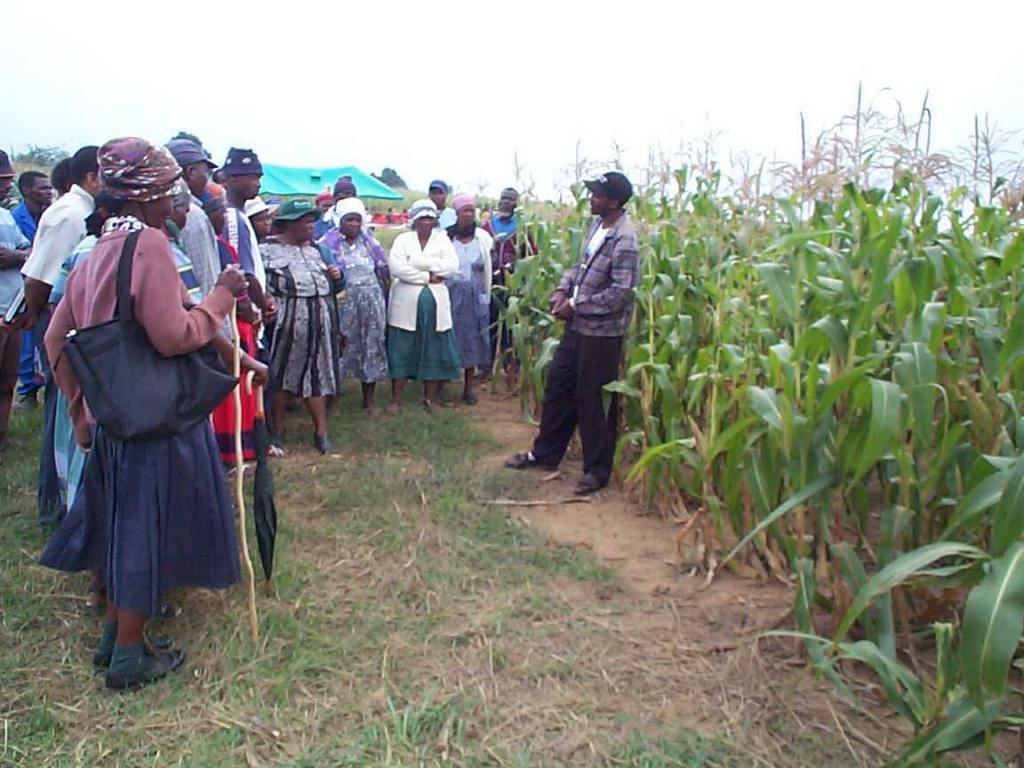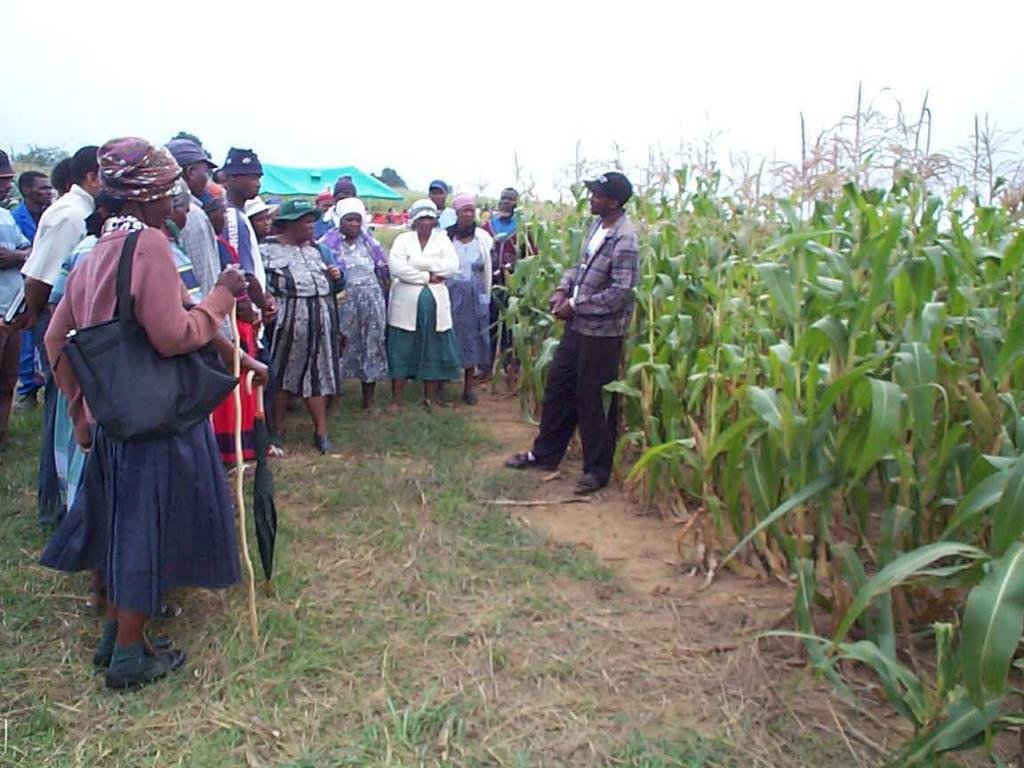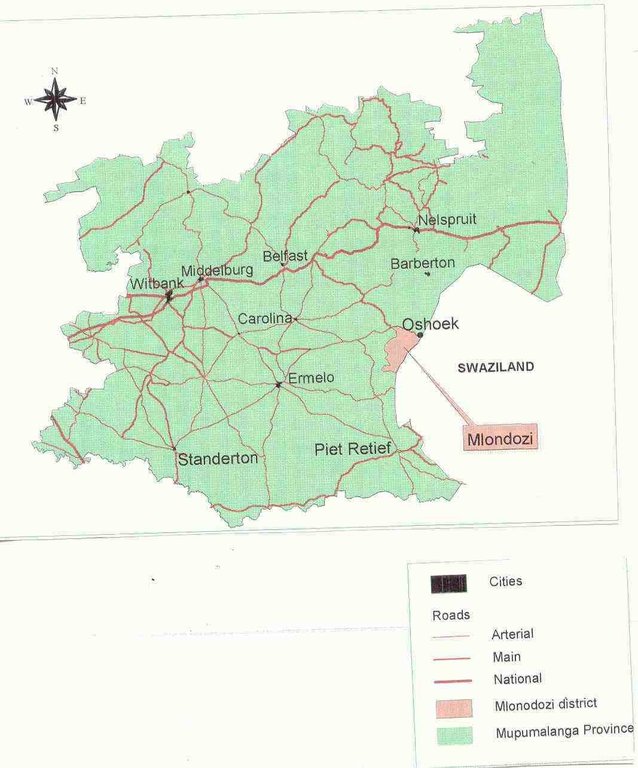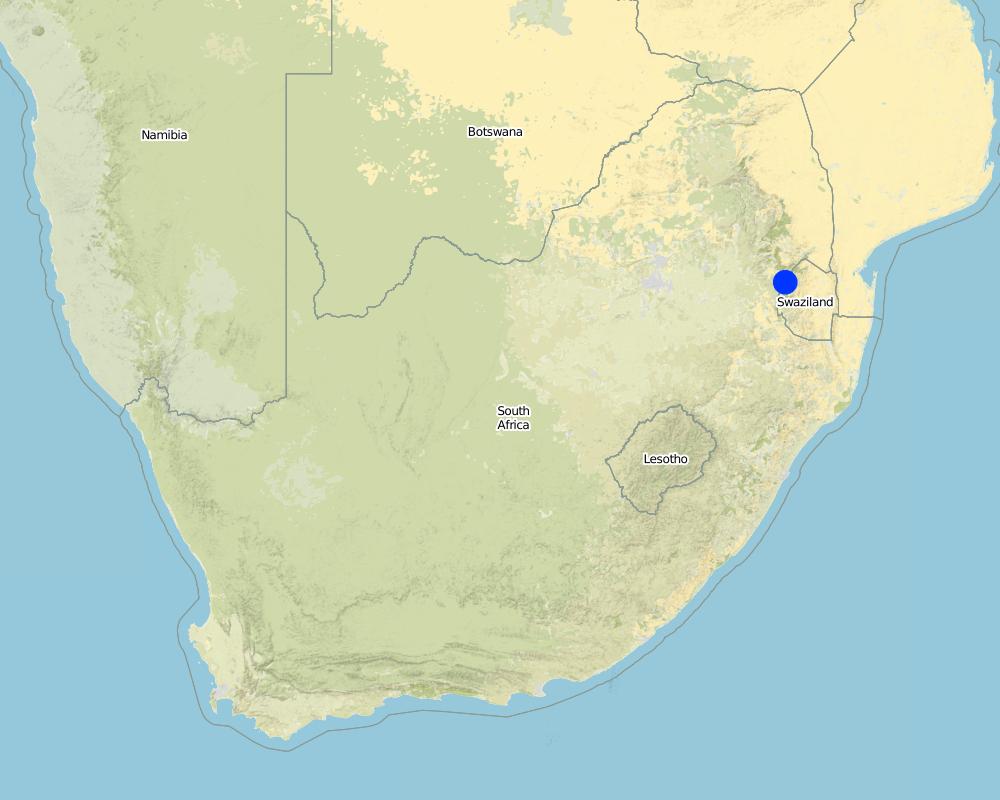Farmers involved in own development [جنوب أفريقيا]
- تاريخ الإنشاء:
- تحديث:
- جامع المعلومات: Hester Gertruida Jansen van Rensburg
- المحرر: –
- المُراجع: Fabian Ottiger
approaches_2337 - جنوب أفريقيا
عرض الأقسام
توسيع الكل طي الكل1. معلومات عامة
1.2 تفاصيل الاتصال بالأشخاص الرئيسيين لمصدر المعلومات والمؤسسات المعنية بتقييم وتوثيق النهج
الشخص (الأشخاص) الرئيسي لمصدر المعلومات
متخصص في الإدارة المستدامة للأراضي:
اسم المؤسسة (المؤسسات) التي سهلت توثيق/تقييم النهج (إذا كان ذلك على صلة)
Agricultural Research Council (ARC) - جنوب أفريقيا1.3 الشروط المتعلقة باستخدام البيانات الموثقة من خلال WOCAT
يوافق جامع المعلومات والشخص (لاشخاص) الرئيسي لمصدر المعلومات على الشروط المتعلقة باستخدام البيانات الموثقة من خلال WOCAT:
نعم
1.4 المراجع الخاصة باستبيان(استبيانات) تقنيات الإدارة المستدامة للأراضي
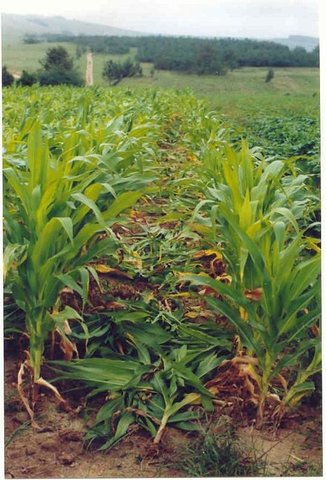
Conservation Agriculture [جنوب أفريقيا]
Conservation agriculture included aspects such as crop rotation, mulching and no-tillage.
- جامع المعلومات: Hester Gertruida Jansen van Rensburg
2. وصف نهج الإدارة المستدامة للأراضي
2.1 وصف موجز للنهج
Planting without ploughing in a crop rotation system to improve moisture management, reduce erosion and increase crop yield.
2.2 وصف تفصيلي للنهج
وصف تفصيلي للنهج:
Aims / objectives: Farmers deal with major problems such as shortages and bad implements, soil erosion and high input costs. The purpose of the project is to involve farmers in their own development, by demonstrating and training in Conservation Agriculture technologies. The methods of doing this include on-farm demonstrations (farm-led) and training courses (discovery-learning courses). The project is in the final stage; the exit plan is already implemented. The participants are both land owners and managers of the project.
2.3 صور عن النهج
2.5 البلد/المنطقة/المواقع التي تم تطبيق النهج فيها
البلد:
جنوب أفريقيا
المنطقة/الولاية/المحافظة:
Mpumalanga
Map
×2.6 تواريخ بدء وإنهاء تنفيذ النهج
سنة الإنهاء (إذا لم يعد النهج مطبقًا):
2002
2.7 نوع النهج
- قائم على مشروع/برنامج
2.8 الغايات/الأهداف الرئيسية للنهج
The Approach focused mainly on SLM with other activities
To empower community to take ownership of the projects. To train community in sustainable utilisation of their Natural Resources. To improve food security.
The SLM Approach addressed the following problems: Physical and chemical degraded land. Changing of attitudes and getting community to take ownership of project.
2.9 الظروف التي تمكن أو تعيق تنفيذ التقنية/التقنيات المطبقة بموجب النهج
توفر/الوصول إلى الموارد والخدمات المالية
- معيق
Agriculture - high input cost with low return
Treatment through the SLM Approach: Reduce input cost
الإطار القانوني (حيازة الأراضي، وحقوق استخدام الأراضي والمياه)
- تمكين/تمكيني
The existing land ownership, land use rights / water rights moderately helped the approach implementation: hinder: moderate
- معيق
No land tenure
Treatment through the SLM Approach:
المعرفة حول الإدارة المستدامة للأراضي، والوصول إلى الدعم الفني
- معيق
Lack of knowledge on improve agriculture technology
Treatment through the SLM Approach: Training
3. المشاركة وأدوار الأطراف المعنية
3.1 أصحاب المصلحة المعنيون بالنهج وأدوارهم
- مستخدمو الأراضي المحليون/المجتمعات المحلية
Mlondozi Community
Working land users were work equally divided between men and women (Men - 60% Women - 40%). Socially disadvantaged included by the Agriculture Development Committee in consultation with farmer groups.
- منظمة غير حكومية
Agriculture Research Council - Institute for Soil, Climate & Water
- الحكومة الوطنية (المخططون، صانعو القرار)
Mpumalanga Department of Agriculture, Environment & Conservation
3.2 انخراط مستخدمي الأراضي المحليين/المجتمعات المحلية في المراحل المختلفة للنهج
| انخراط مستخدمي الأراضي المحليين/المجتمعات المحلية | حدد من شارك وصف الأنشطة | |
|---|---|---|
| المبادرة/التحفيز | الدعم الخارجي | Mainly:interviews/questionnaires; partly: rapid/participatory rural appraisal |
| التخطيط | تفاعلي | Mainly: public meetings; partly: workshops/seminars |
| التنفيذ | التعبئة الذاتية | responsibility for major steps; Study groups/Training/Farm-led demo's |
| الرصد/التقييم | تفاعلي | Mainly: interviews/questionnaires; partly: reporting; |
| Research | سلبي | on-farm; On-farm research - technologies implemented on-farm by farmer-led demo's. |
3.4 اتخاذ القرار بشأن اختيار تقنية/تقنيات الإدارة المستدامة للأراضي
حدد من الذي قرر اختيار التقنية/التقنيات التي سيتم تنفيذها:
- مستخدمو الأراضي بشكل أساسي، بدعم من متخصصي الإدارة المستدامة للأراضي
اشرح:
land user driven (bottom-up).
Decisions on the method of implementing the SLM Technology were made by mainly by land users supported by SLM specialists. land user driven (bottom-up).
4. الدعم الفني وبناء القدرات وإدارة المعرفة
4.1 بناء القدرات/التدريب
هل تم تقديم التدريب لمستخدمي الأراضي / الأطراف المعنيين الآخرين؟:
نعم
حدد من تم تدريبه:
- مستخدمو الأراضي
- SWC specialists, extensionists/trainers
شكل التدريب:
- من مزارع إلى مزارع
- مناطق العرض
- اجتماعات عامة
- دورات
المواضيع المغطاة:
Farm planning/Soil fertility/Management/Post management/No-tillage management/etc.
4.2 خدمة استشارية
هل يملك مستخدمو الأراضي وصولا إلى خدمة استشارية؟:
نعم
حدد ما إذا كانت الخدمة الاستشارية متوفرة:
- في حقول مستخدمي الأراضي
- في مراكز دائمة
- Meetings and courses
وصف/تعليقات:
Name of method used for advisory service: Farming Systems Research & Extension; Key elements: Training, Demonstrations, Participation; 1) Mainly: government's existing extension system, Partly: non-governmental agency. Extension staff: mainly government employees 3) Target groups for extension: land users; Activities: Farmer groups/On-farm - Farmer-led demonstrations
Advisory service is very adequate to ensure the continuation of land conservation activities; Very well understanding of SWC technology.
4.3 تعزيز المؤسسات (التطوير التنظيمي)
هل تم إنشاء أو تعزيز مؤسسات من خلال هذا النهج؟:
- نعم، إلى حد كبير
حدد المستوى (المستويات) التي تم فيها تعزيز أو إنشاء المؤسسات:
- محلي
حدد نوع الدعم:
- بناء القدرات/التدريب
4.4 الرصد والتقييم
هل يشكل الرصد والتقييم جزءا من النهج؟:
نعم
التعليقات:
bio-physical aspects were regular monitored through observations
socio-cultural aspects were regular monitored through observations
economic / production aspects were regular monitored through measurements
no. of land users involved aspects were regular monitored through measurements
management of Approach aspects were regular monitored through measurements
There were few changes in the Approach as a result of monitoring and evaluation: Had to focus more on participatory training.
4.5 البحوث
هل كانت البحوث جزءًا من النهج؟:
نعم
حدد المواضيع:
- تكنولوجيا
أعط تفاصيل إضافية وأشر إلى من قام بالبحوث:
Fertiliser calibration trails/Cultivar (different crops) trails, etc.
Research was carried out on-farm
5. التمويل والدعم المادي الخارجي
5.1 الميزانية السنوية لمكون الإدارة المستدامة للأراضي في النهج المذكور
إذا لم تكن الميزانية السنوية الدقيقة معروفة، قم بالإشارة إلى نطاقها:
- 1,000000-100،000
التعليقات (على سبيل المثال المصادر الرئيسية للتمويل/الجهات المانحة الرئيسية):
Approach costs were met by the following donors: government (national - NDA): 90.0%; international non-government (-): 10.0%
5.2 الدعم المالي/المادي المقدم لمستخدمي الأراضي
هل حصل مستخدمو الأراضي على دعم مالي/ مادي لتنفيذ التقنية/ التقنيات؟:
نعم
5.3 إعانات لمدخلات محددة (بما في ذلك العمالة)
- زراعة
| حدد المدخلات التي تم دعمها | إلى أي مدى | حدد الإعانات |
|---|---|---|
| بذور | ممول جزئيا | |
| أسمدة | ممول جزئيا | |
إذا كان العمل من قبل مستخدمي الأراضي مدخلاً جوهريًا، فهل كان:
- تطوعي
5.4 الائتمان
هل تم توفير ائتمان في إطار نهج أنشطة الإدارة المستدامة للأراضي؟:
كلا
6. تحليل الأثر والتصريحات الختامية
6.1 آثار النهج
هل ساعد النهج مستخدمي الأراضي على تنفيذ وصيانة تقنيات الإدارة المستدامة للأراضي؟:
- لا
- نعم، قليلا
- نعم، باعتدال
- نعم، إلى حد كبير
Conservation Agriculture technology - new technologies (mulch, no-tillage, crop rotation).
هل أدى النهج إلى تحسن في مسائل حيازة الأراضي / حقوق المستخدمين التي أعاقت تنفيذ تقنيات الإدارة المستدامة للأراضي؟:
- لا
- نعم، قليلا
- نعم، باعتدال
- نعم، إلى حد كبير
The problem is likely to be overcome in the near future. Farmers applied for land tenure.
Did other land users / projects adopt the Approach?
- لا
- نعم، قليلا
- نعم، باعتدال
- نعم، إلى حد كبير
Lusikisiki LandCare Project, Bergville LandCare Project, Bizane LandCare Project
6.3 استدامة أنشطة النهج
هل يمكن لمستخدمي الأراضي المحافظة على استدامة ما تم تنفيذه من خلال النهج (بدون دعم خارجي)؟:
- نعم
6.4 نقاط قوة/مزايا النهج
| نقاط القوة/ المزايا/ الفرص من وجهة نظر مستخدمي الأراضي |
|---|
| Like new way of training (How to sustain/ enhance this strength: Learning-by-doing courses) |
| Increase income |
| نقاط القوة/ المزايا/ الفرص من وجهة نظر جامع المعلومات أو غيره من الاشخاص الرئيسيين لمصدر المعلومات |
|---|
| Ownership of project (How to sustain/ enhance this strength: Follow-up meetings and training) |
| On-farm |
| Extension services (How to sustain/ enhance this strength: On-going support) |
6.5 نقاط الضعف/ العيوب في المنهج وطرق التغلب عليها
| نقاط الضعف/ المساوىء/ المخاطر من وجهة نظر جامع المعلومات أو غيره من الاشخاص الرئيسيين لمصدر المعلومات | كيف يمكن التغلب عليها؟ |
|---|---|
| Can only involve a certain amount of farmers every year | Train trainers |
7. المراجع والروابط
7.1 طرق جمع/مصادر المعلومات
- زيارات ميدانية، مسوحات ميدانية
- مقابلات مع مستخدمي الأراضي
7.2 المراجع للمنشورات المتاحة
العنوان، المؤلف، السنة، النظام القياسي الدولي لترقيم الكتب ISBN:
Demonstration and assessment of sustainable land management practices in the Mlondozi district of Mpumalanga. Du Preez, Kidson, Beukes & Smith, 1998, 1999, 2000.
متاح من أين؟كم التكلفة؟:
ARC - ISCW
الروابط والوحدات المواضيعية
توسيع الكل طي الكلالروابط

Conservation Agriculture [جنوب أفريقيا]
Conservation agriculture included aspects such as crop rotation, mulching and no-tillage.
- جامع المعلومات: Hester Gertruida Jansen van Rensburg
الوحدات المواضيعية
لا يوجد وحدات مواضيعية


